The ARCH of Synergy Effects

The Case of Activity Analysis Intervention (AAI) program
On Sept 15, 2022, I introduced the Thematic Journey Map with several case studies. One case study is about "Developing A Service" for Activity Analysis Center.
Activity Analysis Center was born from the Activity U project which is a three-year journey of engaging with Activity Theory. From 2020 to 2022, I run several knowledge projects about Activity Theory. You can find more details in Slow Cognition: Mapping Thematic Journey (Engaging with Activity Theory, 2020 - 2022).

My journey of Engaging with Activity Theory started with knowledge curation and moved to knowledge creation. It started with developing my tacit knowledge about Activity Theory and moved to develop a knowledge center about the "Activity" theme for others.
On August 5, 2022, I start running the Activity Analysis project as an independent knowledge center.

For each knowledge center, I use three keywords to describe its focus. For the Activity Analysis Center, the focus is described with the following themes:
- Curativity
- Creativity
- Activity
The term “Curativity” means the project is a Knowledge Curation project. Activity Theory or the “Cultural-historical activity theory (CHAT)” is an interdisciplinary philosophical framework for studying both individual and social aspects of human behavior.
Though the focus of the Activity U project (2020 to 2022) is Activity Theory, I will expand the scope from Activity Theory to other social practice theories. It means the Activity Analysis Center project is not only about Activity Theory, but also about other social practice theories.

The above diagram represents the mission of the Activity Analysis project: Modeling Social Practices. We aim to connect THEORY and PRACTICE by curating theoretical knowledge, designing service programs, and building a learning community.
Activity Analysis Center will work together with Curativity Center which is a knowledge center for developing Curativity Theory.
You can find more details in Activity Analysis Center: Curativity, Creativity, and Activity.
The Activity Analysis Intervention (AAI) Program
The Activity Analysis Intervention (AAI) Program is the first collaborative project between Activity Analysis Center and Curativity Center.
The AAI program was born with a synergy effect between Activity Analysis Center and Curativity Center.
What's the relationship between Curativity Center and Activity Analysis Center?
See the diagram below.
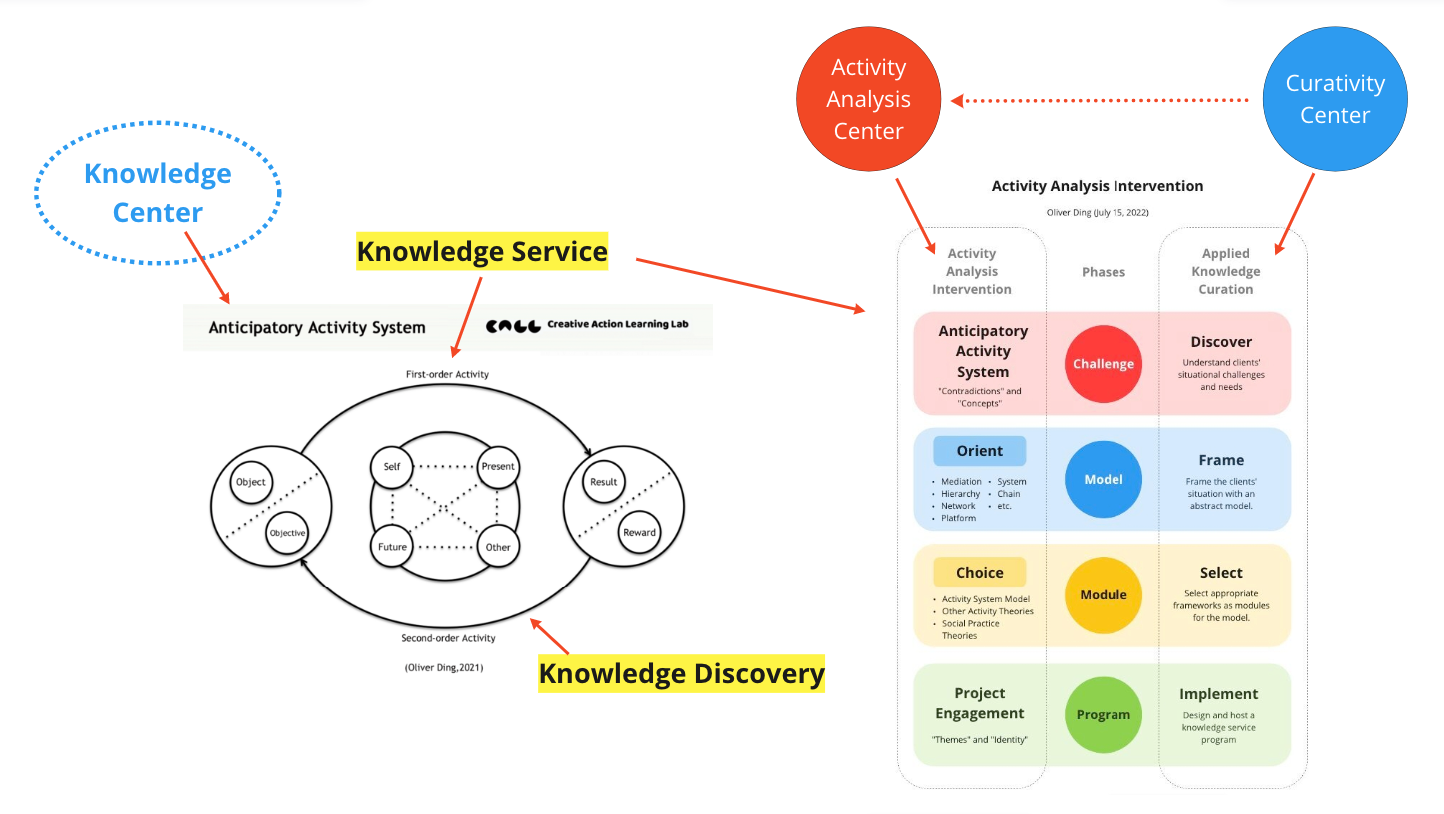
In August 2022, I started working on developing a business model for Activity Analysis Center. As a knowledge center, Activity Analysis Center can be understood as an independent Knowledge Center.
I also used the Anticipatory Activity System (AAS) framework to understand a Knowledge Center:
- First-order Activity: Knowledge Service
- Second-order Activity: Knowledge Discovery
This framework led to a challenge: How does Activity Analysis Center develop a Knowledge Service for practitioners?
Knowledge Service as Developmental Service
On Feb 10, 2022, I published Thematic Space: The Connected Hub and “Service Thinking” and started a new project that aims to connect Activity Theory and other theories with Service. See the diagram below.

The above diagram represents the process of connection. My first spark is SET which stands for “Structured Engagement Theory”. To be honest, it is just a framework, not a theory. However, I want to keep the name “SET” because it points out the core of the framework. In order to keep the name “SET”, I have to keep the word “Theory”. Anyway, let’s call it SET or the SET framework.
In 2019, I started adopting some theories to reflect on my experience and thoughts about “Social (Digital) Design” which refers to digital products for interpersonal communications. Eventually, I developed the SET framework and used it for my own projects later.
The notion of “Developmental Service” is a new idea. I just made it in Feb 2022. It refers to a special type of service such as educational services, summer camps, adult life development programs, life discovery activities, etc. This notion refers to my own perspective of individual development. It also echoes the concept of “Developmental Platform” and the “Developmental Project Model”.
On June 4, 2022, I also wrote an article titled Concept Dynamics: An Ontological Discussion about “Service”.
In July 2022, I developed the Knowledge Engagement Program (v1) for a client. Though the program focuses on “Service Knowledge Management”, it can be considered a general program for applying the Project Engagement approach to Knowledge Management.
The program used the Anticipatory Activity System framework to develop the model. See the diagram below.

I adopt the “Anticipatory Activity System (AAS)” framework to understand “Service Knowledge Management”:
- First-order Activity: Software Product Development
- Second-order Activity: Service Knowledge Management
Why do we need to use the AAS framework? If we don’t understand the first-order activity, then we can’t understand the second-order activity. You can find more details in The AAS framework for Life Strategy and Service Knowledge Management.
Later, I realized that I can apply the same framework to "Knowledge Center".
- First-order Activity: Knowledge Service
- Second-order Activity: Knowledge Discovery
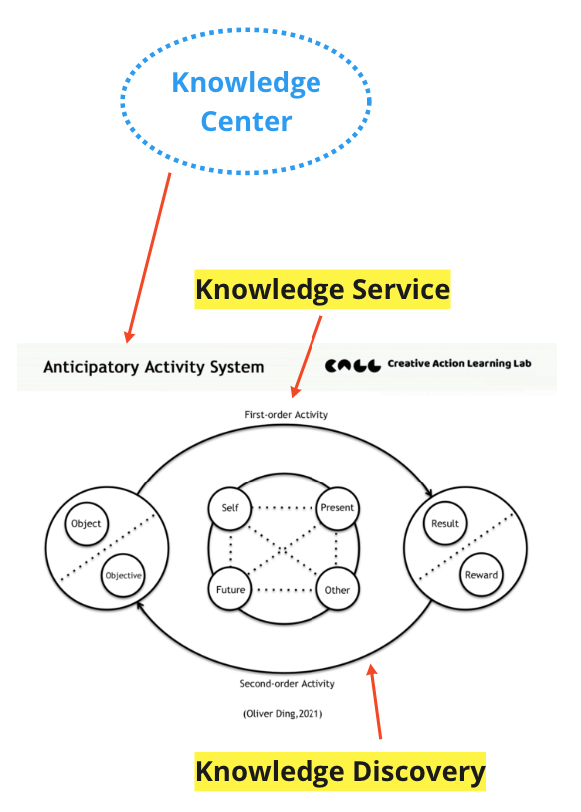
As mentioned above, there are many approaches in the field of Activity Theory and Social Practice theories. Thus, there is an opportunity for Activity Analysis Center.
It could offer Applied Knowledge Curation for practitioners who want to apply Activity/Practice approaches for practical works.
Applied Knowledge Curation
On July 12, 2022, Curativity Center developed the Applied Knowledge Curation framework.
In the past several months, I designed several toolkits and programs by curating knowledge frameworks as modules. Eventually, I used Applied Knowledge Curation to define this activity.
To my surprise, the process of Applied Knowledge Curation echoes the TSI meta-methodology which is introduced by Mike Jackson in the 2003 book Systems Thinking: Creative Holism for Managers.
The TSI methodology stands for Total Systems Intervention. Its three phases are labeled Creativity, Choice, and Implementation.
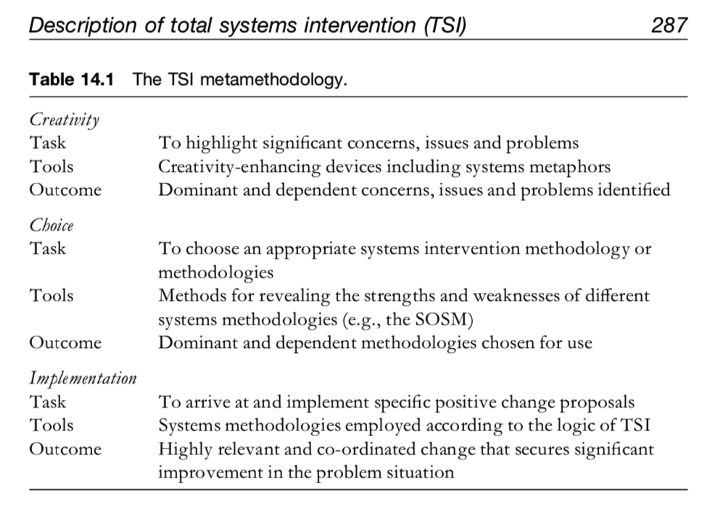
As a dynamic meta-methodology, TSI should be considered as a continual cycle around creativity, choice, and implementation.
Both TSI and Applied Knowledge Curation adopts can be understood as three-phase activities: 1) understanding the challenge, 2) developing a solution, and 3) implementing a program to deliver the solution.
See the diagram below.
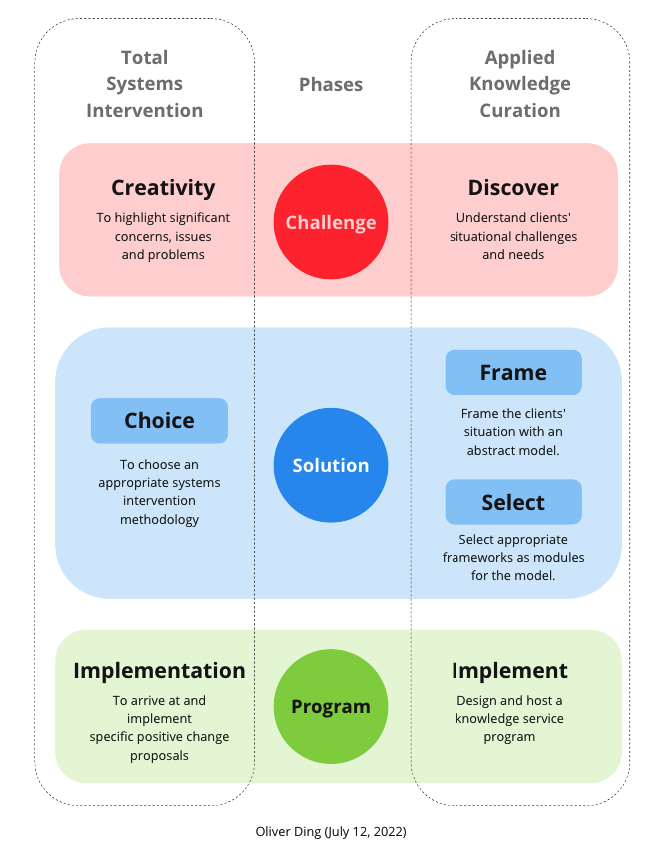
In phase 2, there is a difference between TSI and Applied Knowledge Curation. For TSI, phase 2 means choosing an appropriate systems intervention methodology as a dominant approach. For Applied Knowledge Curation, I have to achieve the goal with two steps:
- 1) frame the clients’ situation with an abstract model, and
- 2) select appropriate frameworks as modules for the model.
Why did I need to take two steps while TSI only needs one step for phase 2?
The answer is the Maturity of knowledge frameworks.
TSI’s knowledge resources are well-developed systems approaches. Each approach has been developing for many years. However, my approach to Applied Knowledge Curation only considers selecting modules from my frameworks.
You can find more details in The Curated Mind: Creative Holism and Applied Knowledge Curation.
Activity Analysis Intervention (AAI)
Activity Analysis Center adopted the Applied Knowledge Curation framework to develop a new service called Activity Analysis Intervention.
See the diagram below.
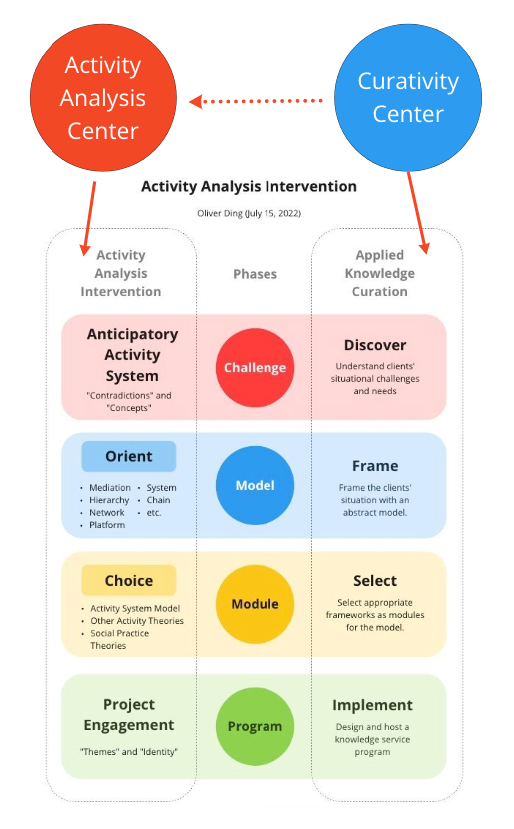
The Activity Analysis Intervention program aims to offer a Theory-based Reflection solution for practitioners. It doesn't want to directly solve problems for practitioners but offers a new way to improve mindset by adopting theoretical perspectives.
I roughly consider the following four steps for Activity Analysis Intervention:
- Challenge
- Model
- Module
- Program
I will use my journey of "Engaging with Activity Theory" as an example.
Challenge
This step is about Discovery. It aims to understand clients' situational challenges and needs.
For the journey of "Engaging with Activity Theory", my situational challenge is reflecting on my three years of journey about Activity Theory. I need both theoretical frameworks or concepts and methods to help me understand four major projects as a meaningful whole.
The clients' challenges can be self-reflection, team change, or the transformation of social systems. My challenge is self-reflection.
Model
This step is about Orientation. It aims to frame clients' situations with an abstract model. This step is pretty unique because the method doesn't want to directly solve concrete problems.
The abstract model can be a rough perspective or dimension such as "hierarchy", "network", "mediation", "platform","development", "transformation", "contradiction", etc.
For example, Clay Spinuzzi selected the "Network" perspective for his project "Theorizing Knowledge Work in Telecommunications".
In ordr to curate four projects as a meaningful whole, I used "Journey" and "Project" as metaphors to build the basic model.
Though "Journey" is not a theoretical concept of Activity Theory, I can use it as a metaphor for Orientation which only needs a rough connection.
Module
The third step is about Selection. It is about selecting appropriate frameworks as modules for the model. The field of Activity Theory and Social Practice theories has many theoretical approaches and frameworks. We can choose some frameworks and curate them together as a practical toolkit.
For example, Clay Spinuzzi selected "Activity Network" and "Actor-network Theory (ANT)" for his project.
There are three significant aspects of my journey of "Engaging with Activity Theory": Themes, Instruments, and Individuals. Activity Theory is a large knowledge enterprise, its primary theme is "Activity". I also noticed that I made several tools for the journey. Finally, my journey is an independent exploration. Thus, I considered "Instruments" as the primary dimension and selected Lev Vygotsky's "Mediating Action" as the primary model because it is about individual actions.
I also selected several ideas from other approaches for Primary Operational Concepts and Secondary Operational Concepts.
Each operational concept can refer to a related model or framework. Since these frameworks are part of my tacit knowledge, I can use them easily.
For other people, it may take time to learn these related models. Or, we can let them select frameworks for operational concepts.
Program
The final step is about Implement. It means designing and hosting an intervention program with the practical toolkit which is the outcome of the above steps.
My case is for self-reflection, so the implement is very simple. I just need to collect facts about the four projects and put them on the Thematic Journey Map. I also conducted "Mapping Developmental Project" for each project.
If we apply the "Activity Analysis Intervention" program to team change and the transformation of social systems, then the Implement step could be complicated.
As mentioned above, the Activity Analysis Intervention program aims to offer a Theory-based Reflection solution for practitioners. The Implement step should be run by practitioners because they need to directly solve problems in their own situations.
The ARCH of Synergy Effects
The Activity Analysis Intervention program is a good example of Synergy Effects.
There are many approaches to understanding Synergy Effects, I will use the ARCH model for the present discussion.
The ARCH model only considers the interactions between two subjects which is a basic unit of a large system. See the diagram below.
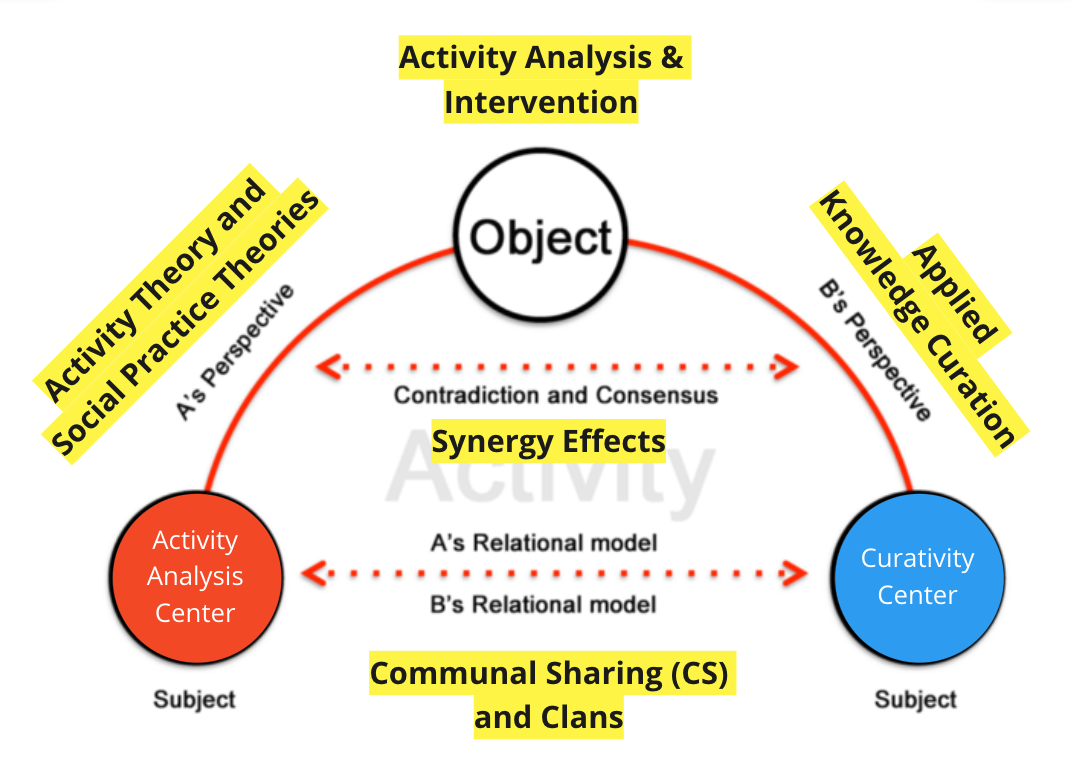
The ARCH diagram is a meta-diagram for discussing conflict, consensus, and intersubjectivity.
In 2020, I used the ARCH diagram to curate Alan P. Fiske's Relational Models Theory and Clay Spinuzzi’s typology of Activity.
The original version of ARCH model only considers Contradiction and Consensus. This case study will expand its object to Synergy Effects.
Clay Spinuzzi’s typology of Activity
In 2014, I started learning Activity Theory. After reading some books and papers about Activity Theory, I moved to search for some typologies of activities. In 2015, I found Clay Spinuzzi’s paper Toward a Typology of Activities: Understanding Internal Contradictions in Multiperspectival Activities. He pointed out, “AT (Activity Theory) currently lacks a suitable typology for characterizing ideal types of activities in terms of multiperspectivity, so it has had trouble systematically characterizing the resulting sets of internal contradictions.”
He proposed a new matrix with the following two dimensions:
- How is the object defined? Is it defined explicitly and deductively or tacitly and inductively?
- Where is the object defined? Is it defined within the activity’s division of labor or outside it?
The outcome is a matrix with four quadrants (see the diagram below) which represent four ideal activity types.
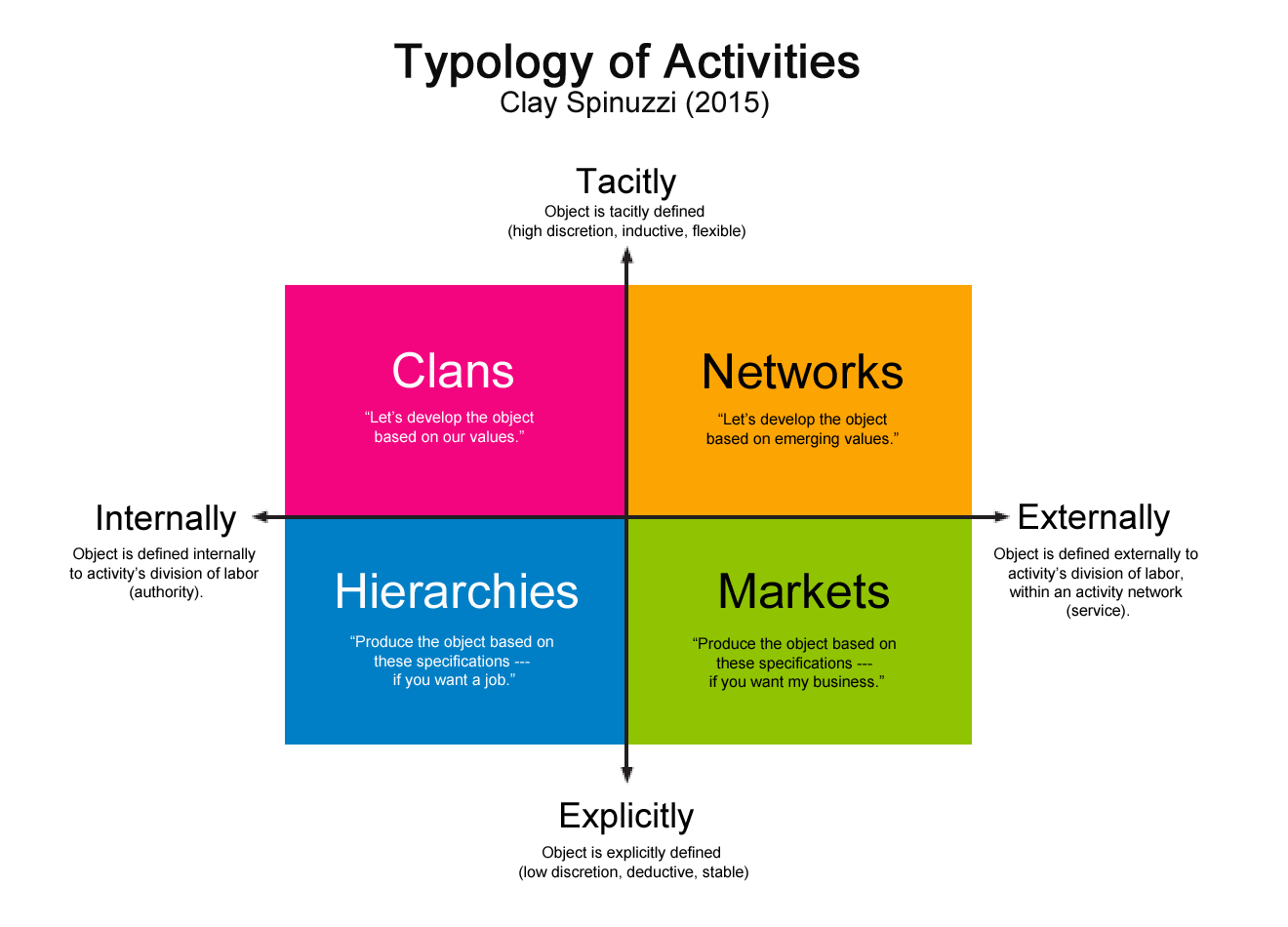
Spinuzzi named these four ideal types of activities as Hierarchies, Markets, Clans, and Networks. We have to notice these words are just names of ideal types.
You can find more details in A Typology of Activities [Activity Theory].
Alan P. Fiske's Relational Models Theory
In 1992, Alan P. Fiske published a paper titled The Four Elementary Forms of Sociality: Framework for a Unified Theory of Social Relations on Psychological Review. Fiske argued that people in all cultures use just four relational models to generate most kinds of social interaction, evaluation, and affect.
These four models are Communal Sharing (CS), Authority Ranking (AR), Equality Matching (EM), and Market Pricing (MP). In communal sharing, people treat all members of a category as equivalent. In authority ranking, people attend to their positions in a linear order. In equality matching, people keep track of the imbalances among them. In market pricing, people orient to ratio values.
In a broad sense, these four modes roughly match Spinuzzi’s four ideal types of activities (see the diagram below).
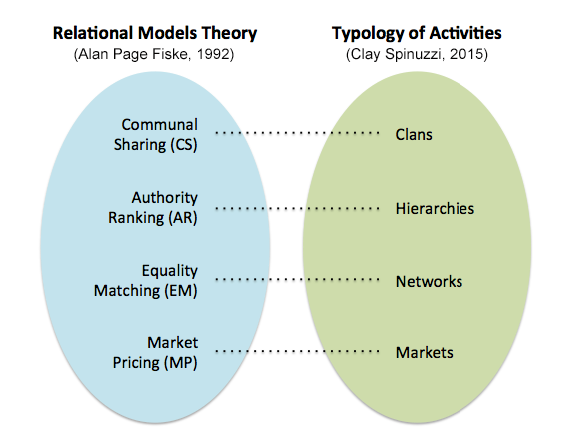
Are they saying the same thing with different words?
A major difference is that these two frameworks work on two levels, Relational Models Theory is about individual psychological models while Typology of Activities is about collective activities. The former is an actor-centered perspective while the latter is an activity-centered perspective.
Multiperspectivity, Contradictions, and Relationship
Activity theorists often talk about “multiperspectivity” and “contradictions”. Spinuzzi (2015) said, “Activities are multiperspectival in that different people who are involved in the same activity tend to perceive different aspects of it and consequently tend to pulse the shared object in different ways, with different tempos, using different configurations of the resources.”
Fiske also pointed out the conflict in social life, “What is crucial isn’t just that there are four ways in which we relate to each other. It’s that misunderstandings and conflict in social life occur because two of us are using different models, or using the same model in different ways. Interacting with co-workers, spouses or neighbors, we take it for granted that the other person is using the same model we are. Often we are wrong.” (Source: Basic Relationships)
Based on a meta-diagram called ARCH, I drew the diagram below to combine Fiske’s model and Spinuzzi’s framework for our discussion.

The above diagram represents a basic joined action with two people: person A (subject A) and person B (subject B).
- Following Activity theory’s terms, this action is part of a collective activity with a shared Object. Subject A and Subject B have their own perspectives on the Object, these perspectives may generate contradictions or consensus.
- Relational Models Theory doesn’t have the term “object”. Fiske just directly talked about social interactions and social relationships. Person A and person B have their own relational models for a particular interaction. These difference models might generate contradictions or consensus too.
Spinuzzi said, “In a complex collective activity, different stakeholders may have different motives and perspectives on the shared object. In any collective activity, an object is ‘‘multifaceted, evolving,’’ and even ‘‘dialogical’’, understood differently by different participants at different points, developing over time. Activities become polycontextual and polymotivated; stakeholders become more heterogeneous…Activity theorists have recognized this issue of multiperspectivity and its resulting internal contradictions. Such contradictions may become more prevalent and important as activities become more connected and interpenetrated. In response, activity theorists have attempted to describe different types of activities in order to better characterize such internal contradictions.”
Activity theorists don’t talk about “relationship” directly, they like “contradictions” because it drives the development and transformation of activity. According to Nicolini (2012), “…the (activity) theory addresses the traditional opposition between change and stability. One of the great merits of the theory is to provide strong support to the idea that, from a practice-based perspective, change and not stability is primordial.” (p.118)
Fiske paid attention to similar contradictions, but more to individual personal behavior and emotion. He said, “One member of a work team assumes implicitly that it is a matching operation — each person on the team should contribute equally. But others assume the task is a shared responsibility of the group as a whole, so everyone should simply pitch in and do whatever is necessary. The sharers are offended when the matchers keep precise track of how much each person does. The matchers get angry when the sharers fail to take regular turns, or when one sharer does extra work and the matchers don’t try to keep up. Everyone is doing something reasonable and legitimate, but people offend each other because they are operating with different models. It doesn’t occur to them that the others have different unstated assumptions about how to coordinate.”
Fiske also used marriage as an example to discuss conflicts, “One spouse is a pricer. He assumes household repairs and cooking should be done in the most efficient way possible. Whoever can do a task quickest ought to take care of it. The other spouse is a matcher. She assumes work should be divided equally into matching tasks. The pricer gets irritated when the matcher tries to take a turn doing jobs she can’t do quickly or well. It seems to him inefficient and silly. The matcher is hurt that the pricer doesn’t take turns cooking and doesn’t appreciate her trying to pitch in on electrical repairs. Both are trying to be responsible (acting in accord with the model they take for granted.) Neither can understand why the other one fails to do what makes sense.”
This example is about conflicts on “division of labor” which is a term of activity theory. Now, we can say these two frameworks can work together. Spinuzzi’s typology is more about collective configurations of activity while Fiske’s framework is more about individual moral intuitions on social interaction.
When Activity Analysis Center Meets Curativity Center
Now we can use the ARCH model to explain the AAI program.
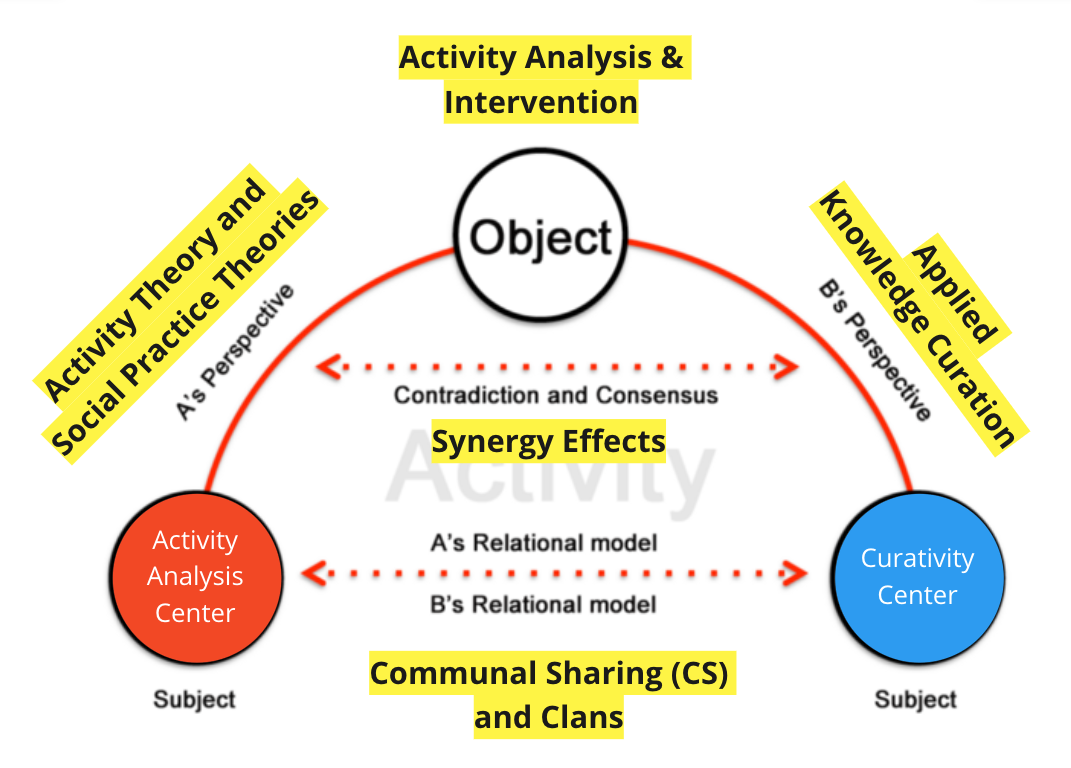
The above diagram highlights facts about the AAI program.
- Subject A: Activity Analysis Center
- Subject B: Curativity Center
Though the original ARCH model is about people. We can understand "Subject" in general. For the present discussion, I consider Activity Analysis Center as Subject A, Curativity Center as Subject B. In this way, we can use the ARCH model for our discussion.
- Object: Activity Analysis & Intervention (the AAI program)
The shared object between Activity Analysis Center and Curativity Center is the Activity Analysis & Intervention (AAI) program. I'd like to emphasize that the shared object is dynamic. There is a process of developing the shared object.
I roughly defined the process as three phases:

In the first phase, two subjects share the same space. In this way, they can meet each other. They can stay together. For the AAI program, two subjects are both members of the "Curativity" knowledge enterprise.
In the second phase, two subjects share the same theme which refers to aboutness. It means they think about the same thing. For the AAI program, the shared theme is "Developing A Knowledge Service" for Activity Analysis Center.
In the third phase, two subjects share the object which means the same objective and things they want to work on. For the AAI program, they realized that "the Knowledge Service" could be "an Applied Knowledge Curation program".
- Relational Model: Communal Sharing (CS) and Clans
For the AAI program, Activity Analysis Center and Curativity Center are both members of the "Curativity" knowledge enterprise. So, A's Relational Model and B's Relational Model are the same type: Communal Sharing (CS) and Clans.
For other cases, A's Relational Model and B's Relational Model can be different types.
- A's Perspective: Activity Theory and Social Practice Theories
- B's Perspective: Applied Knowledge Curation
For the AAI program, Activity Analysis Center's perspective refers to a set of theoretical approaches in the field of Activity Theory and Social Practice Theories in general.
Curativity Center's perspective refers to the Applied Knowledge Curation framework.
As mentioned above, there is a three-phase dynamic process, Subject A and Subject B can exchange more than one perspective and find some relevant matches.
- Synergy Effects: the significant insight about the AAI program
A relevant match between two subjects around a shared theme lead to a significant insight:
a) Since there are many theoretical approaches in the field of Activity Theory and Social Practice Theories...
b) ...Curativity Center can help Activity Analysis Center develop an Applied Knowledge Curation program...
c) ...Activity Analysis Center can run an Applied Knowledge Curation program as its first knowledge service program.
The above case study represents a model of using the ARCH framework to understand the dynamic process of Synergy Effects.
Mapping Synergy Effects
Why do I claim a collaborative project between Curativity Center and Activity Analysis Center has a Synergy Effect?
In the past three years, I worked on Developing Knowledge Themes. This year I moved to the next stage: Building Knowledge Centers.
I am currently running five knowledge centers.
- Curativity Center
- Activity Analysis Center
- Creative Action Learning Lab (CALL)
- Platform Ecology Center
- Life Strategy Center
You can find my knowledge themes and these five knowledge centers in the diagram below. You can also find a large version of the diagram in Slow Cognition: Mapping Thematic Landscape (Curativity, 2019 - 2022).
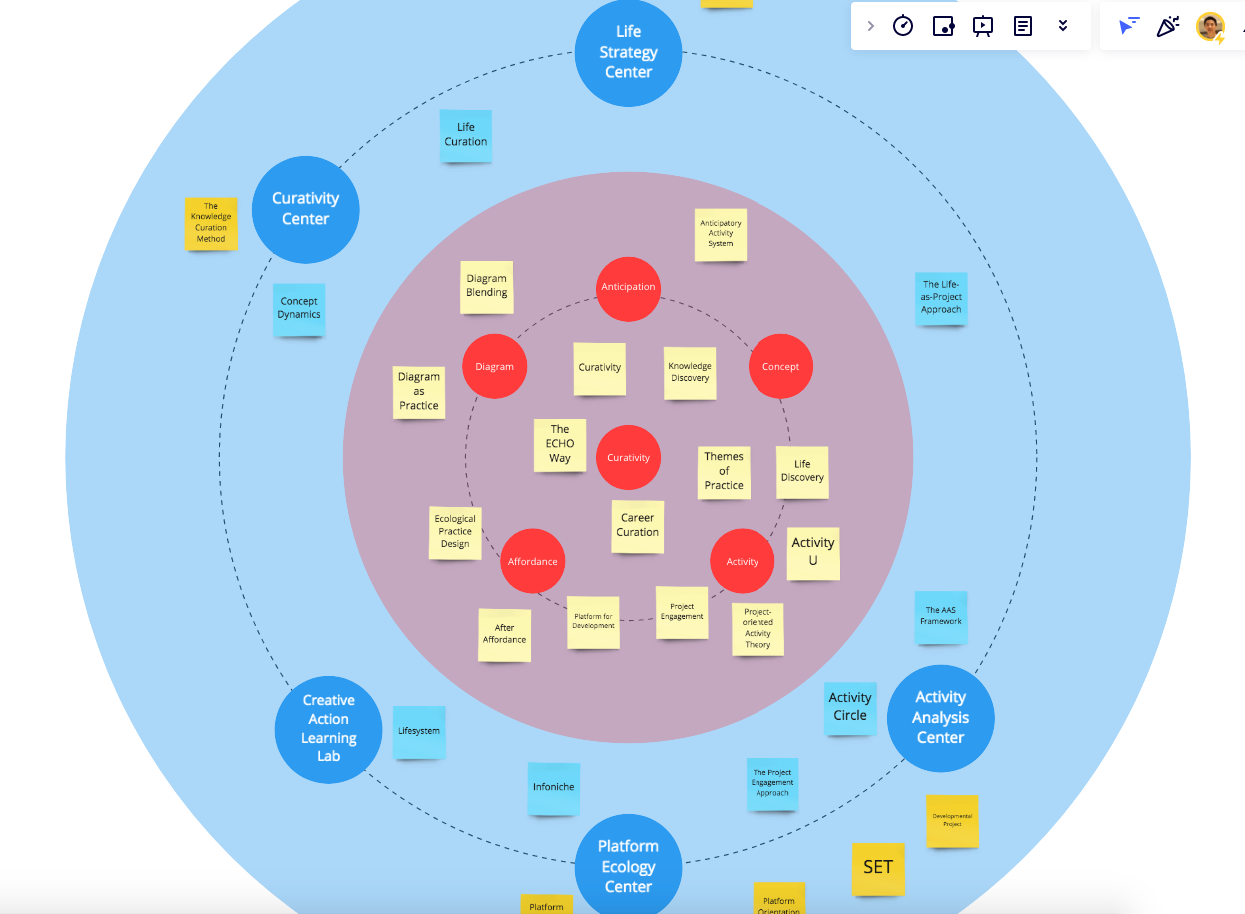
The above five knowledge centers are part of my "Curativity" knowledge enterprise.
If we consider a Knowledge Enterprise as a system, then we can apply the term "Synergy Effects" to discuss related events.
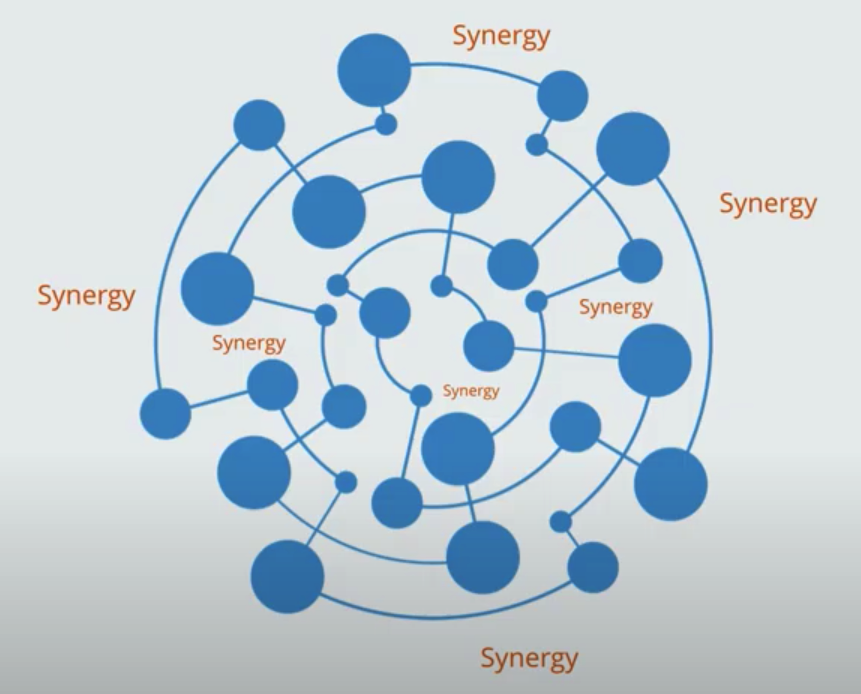
For the "Curativity" knowledge enterprise, "Synergy Effects" can be found in collaborative projects between two or more knowledge centers.
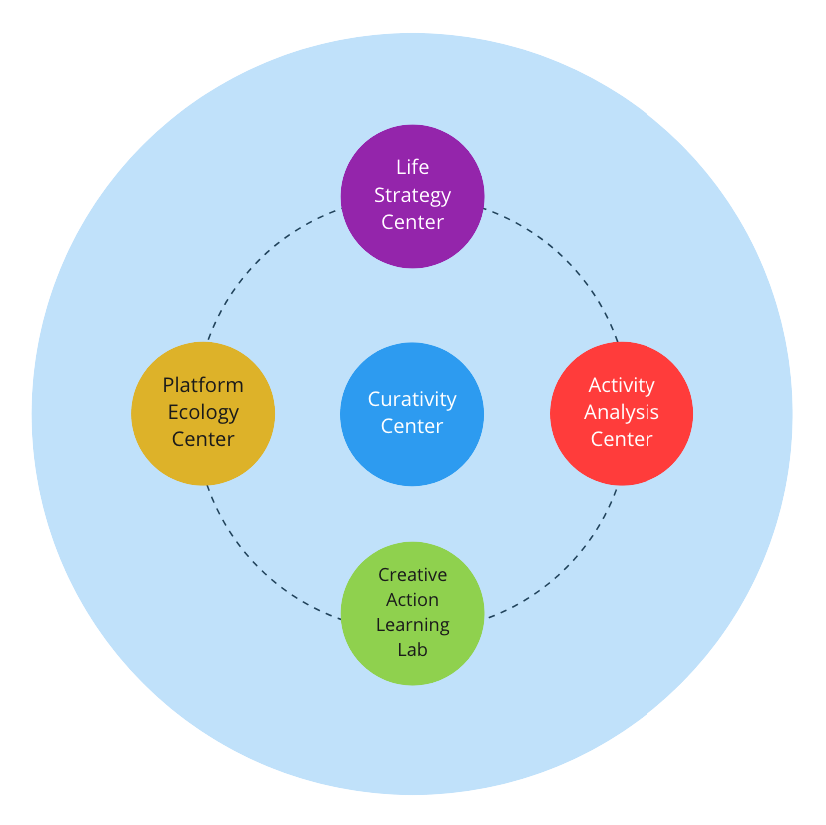
"Synergy Effects" can be found in local programs between different entities. For example, I launched the Life Engagement Program and the Biographical Engagement Project on Sept 5, 2022. See the diagram below.
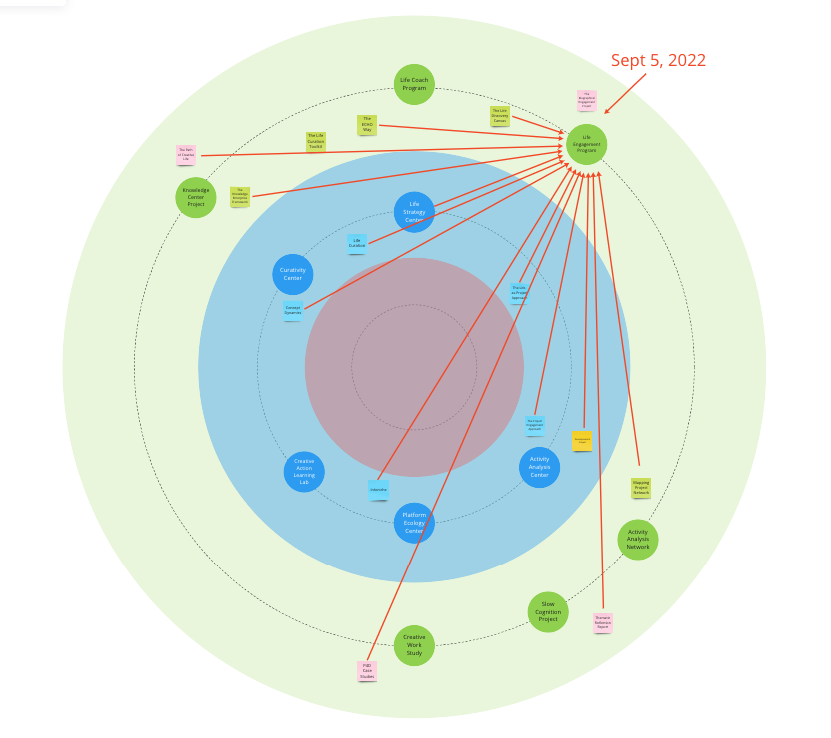
Though I use the Life Strategy Center to host a project about reading biographies. The above diagram represents many connections between the Biographical Engagement Project and other entities within my "Curativity" knowledge enterprise.

In this way, we can use Thematic Landscape Map to discover Synergy Effects.
We can also apply the ARCH model to discuss Synergy Effects between knowledge centers.
